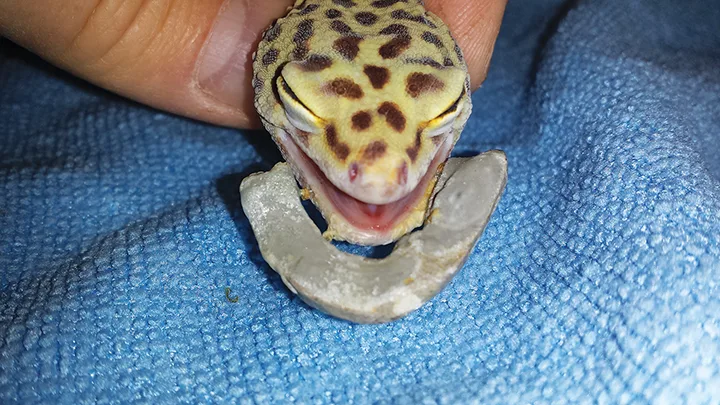Size Is Not a Factor in Standard of Care
Adolf K. Maas, III, DVM, DABVP (Reptile & Amphibian), CertAqV, ZooVet Consulting, Bothell, Washington
In the Literature
Nau MR, Eshar D. Rostral mandibular fracture repair in a pet bearded dragon (Pogona vitticeps). J Am Vet Med Assoc. 2018;252(8):982-988.
The Research …
Orthopedic injuries can occur in any animal, including nontraditional species. Standard hardware used for domestic animals (eg, plates, screws, intramedullary pins, external fixator apparatus) are often too large to use in many exotic animals, so clinicians must be inventive and use supplies that are commonly available.
This case report exemplifies how success can be obtained by combining best practice methods with creativity. The patient in this report, a lizard weighing approximately 300 g, had a comminuted mandibular fracture requiring stabilization. Because the bone in need of stabilization was only 4 to 6 mm across, the authors repurposed 25-gauge needles, which are commonly found in veterinary practices, into 0.5-mm external fixator pins and bonded them together using intravenous tubing filled with dental acrylic. In addition, 36-gauge orthopedic wire cerclage loops were used to stabilize a comminuted fragment for improved alignment.
Techniques used in standard companion animal practice (see Suggested Reading) are immediately relevant in exotic animal practice and should be implemented for exotic animals, as this report illustrates. Although the patient was a small reptile as opposed to a traditional companion animal (eg, cat, dog), radiographs and a serum chemistry profile were obtained prior to anesthesia to conduct an accurate assessment of the injury and evaluate general health. The patient was administered analgesia, anesthetized, and intubated for orthopedic repair. Normal activity and appetite returned within 24 hours postoperation. Because reptiles heal slower than mammals, time was allowed for the patient to heal completely (ie, 5.5 months postoperatively), and healing was confirmed radiographically before all hardware was removed.
Using alternative materials and modified techniques is not uncommon in exotic animal medicine.1 Because techniques are mostly universal, modifications rely on knowledge of specific variations on anatomic themes, as well as applications of different materials.2 In many cases, knowledge of applications in one taxon can be easily applied to other taxa.3-5 This practice can be applied to any situation in nontraditional species medicine. Intravenous catheterization can be performed in most small mammals, as well as many birds and reptiles; however, in cases in which intravenous placement may not be feasible, intraosseous catheterization is simple and effective. Blood analysis is possible in any species, provided the clinician is familiar with species-specific collection sites. Surgery is only limited by the clinician’s skill and willingness; goldfish can have coelomic masses removed, hamsters may require intestinal resection and anastomoses, canaries may require fracture repair, and turtles may need to be spayed.

FIGURE 1
Leopard gecko with external fixator for bilateral mandibular fractures. Twenty-seven–gauge needles were used as intramuscular pins, with epoxy putty used as a connector.
… The Takeaways
Key pearls to put into practice:
Patient size is not a limitation; the only limitation is the clinician’s training and skill.
Most veterinary practices have equipment and instruments necessary to practice high-quality medicine in all patients.
The same standard of care can be applied to both domestic companion animals and nontraditional species.